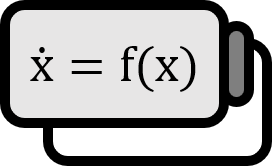SEIR Model: Latent Period and Incubation Period
Overview
The SEIR model is an epidemiological compartment model that adds an exposed group to the SIR model.
Model 1 2

$$ \begin{align*} {{d S} \over {d t}} =& - {{ \beta } \over { N }} I S \\ {{d E} \over {d t}} =& {{ \beta } \over { N }} S I - {{ 1 } \over { \tau }} E \\ {{d I} \over {d t}} =& {{ 1 } \over { \tau }} E - \mu I \\ {{d R} \over {d t}} =& \mu I \end{align*} $$
Variables
- $S(t)$: Represents the number of individuals in the population who are susceptible to getting sick at time $t$.
- $E(t)$: Represents the number of individuals who are in the exposed group at time $t$.
- $I(t)$: Represents the number of individuals who are capable of transmitting the disease at time $t$.
- $R(t)$: Represents the number of individuals who have recovered at time $t$.
- $N(t) = S(t) + E(t) + I(t) + R(t)$: Represents the total population.
Parameters
- $\beta>0$: The infection rate.
- $1/\tau>0$: The average latency period.
- $\mu>0$: The recovery rate.
Description
Because diseases typically don’t show symptoms and spread immediately upon exposure, the SEIR model is considered more realistic than the SIR model. Within the context of disease spread modeling, the exposed group $E$ can be seen as individuals who have come into contact with an infected person and have acquired the pathogen, and though they will soon fall ill, they are not yet infectious.
Incubation and Latent Periods
$\tau$ is commonly referred to as both the Incubation Period and Latent Period, though in infectious disease terminology, the period until clinical symptoms appear is defined as the incubation period, and the period until one becomes infectious is defined as the latent period.3
In mathematical modeling, the period before becoming infectious without yet being symptomatic is called the latent period. If there is some infectiousness, even if reduced, it’s considered the incubation period. Considering the Viral Load, which can increase over time, makes this distinction significant.
Incidence and Prevalence
Since there is a difference between the time of exposure and symptom onset in the model, incidence and prevalence must also be distinguished. The number of cases transitioning from $E$ to $I$ during a specific period $\Delta t$ is called The number of Incidence Cases, and the ratio of individuals with the disease at a specific point in time $t$ is referred to as the prevalence.
In reality, Incidence refers to diagnosing whether one has contracted the disease, hence it is also termed Confirmed.
Stochastic Model
In models such as simulations instead of ordinary differential equations, $\tau$ could be treated as a random variable. While its distribution depends on the disease in question, it often considers Weibull distribution or Gamma distribution.
Allen. (2006). An Introduction to Mathematical Biology: p275. ↩︎
Capasso. (1993). Mathematical Structures of Epidemic Systems: p59. ↩︎
복지부 장관도 헷갈리는 바이러스 ‘잠복기’ 용어 http://www.docdocdoc.co.kr/news/articleView.html?idxno=1076727 ↩︎
